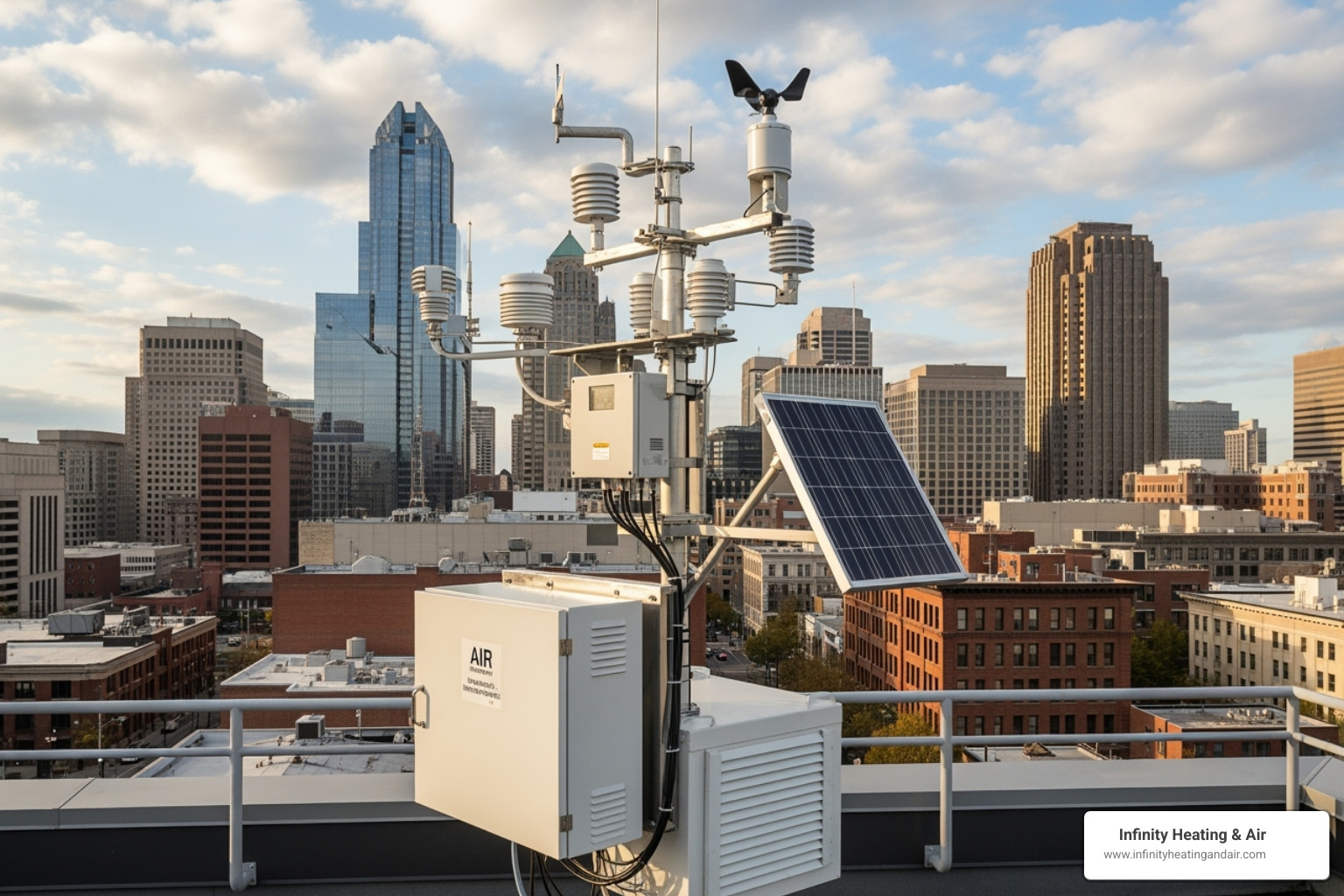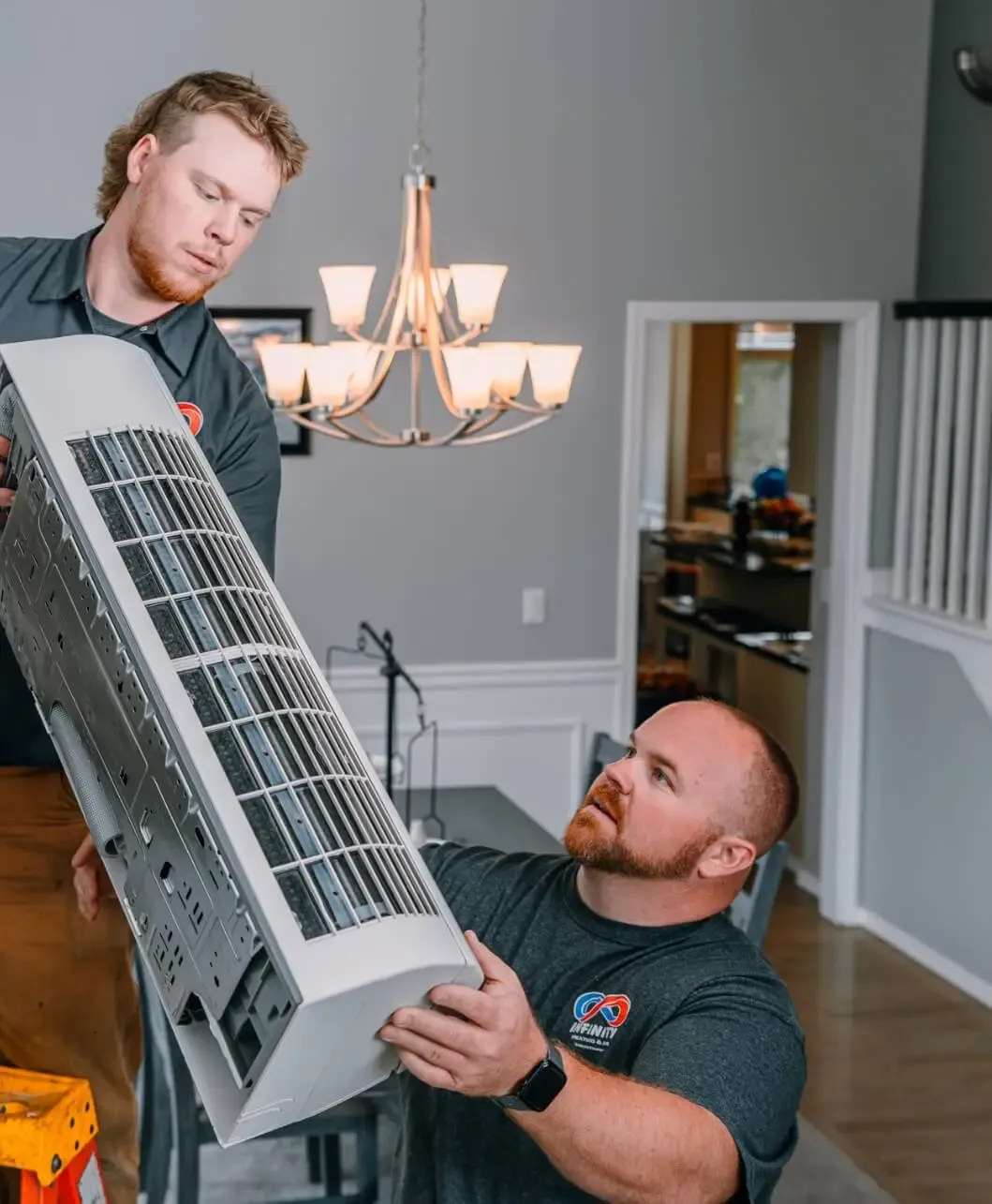
Infinity Heating & Air: Washington’s Indoor Air Quality Guide
Washington air quality solutions by Infinity Heating & Air. Protect your home from pollutants and wildfires with our expert HVAC services in 2025.
.webp)

Why Air Quality Matters for Washington Homeowners
Air quality Washington is a growing concern for homeowners across the Evergreen State. Here’s what you need to know:
- Current Status: Washington’s air quality is generally good, but episodes of unhealthy air occur regularly.
- Main Threats: Wildfire smoke, winter wood burning, and vehicle emissions.
- Seasonal Patterns: Winter brings wood smoke pollution; summer increases wildfire and ozone risks.
- Health Impact: Poor air quality affects sensitive groups first, then the general population.
- Protection: Indoor air quality solutions create a safe haven when outdoor air is unhealthy.
Washington’s reputation for clean air faces new challenges. Wildfire smoke creates hazy skies across the Puget Sound, giving the sun and moon an eerie red glow. The Seattle skyline often disappears behind a curtain of smoke during fire season.
The numbers tell the story: While 98% of Washington cities met WHO air quality targets in 2019, the 2020 wildfire season brought over a week of “unhealthy” or worse air quality to Seattle, Tacoma, Everett, Bellevue, and Kent.
For Northwest Washington homeowners, understanding air quality is about protecting your family’s health and creating a comfortable home when outdoor air is unsafe. The Air Quality Index ranges from 0-50 (Good) to 301+ (Hazardous), with each level requiring different precautions. When Kennewick’s AQI recently exceeded 100, residents were advised to limit outdoor activities and stay indoors.

Understanding Washington’s Air: Pollutants and the AQI
When you check your weather app, that little number is the Air Quality Index (AQI). It’s a report card for the air, telling us how clean or polluted it is daily.
The AQI measures five major pollutants, but in Washington, we mainly worry about two: particulate matter (PM2.5) and ground-level ozone.
The good news? Air quality Washington typically scores well, often sitting in the “Good” range. We’ve recently seen stable readings between 21 and 25.
But don’t get too comfortable. During wildfire season, these numbers can spike. That’s when checking the Washington Air Quality Map becomes routine.
What the Air Quality Index (AQI) Colors Mean
The AQI uses a simple color code:
- Green (0-50) is “Good”: Air is satisfactory for outdoor activities.
- Yellow (51-100) is “Moderate”: Most people are fine, but sensitive individuals should be cautious.
- Orange (101-150) is “Unhealthy for Sensitive Groups”: People with heart or lung disease, older adults, children, and pregnant women should limit outdoor exertion.
- Red (151-200) is “Unhealthy” for everyone.
- Purple (201-300) is “Very Unhealthy”: A health alert for everyone.
- Maroon (301+) is “Hazardous”: Emergency conditions for the entire population.
Understanding these codes helps you decide when to stay inside with an air purifier. For more details on interpreting AQI values, AirNow.gov has excellent resources.
Major Pollutants in Washington’s Air
Particulate Matter (PM2.5) is our biggest concern. These microscopic particles are small enough to enter your lungs and bloodstream.
Wildfire smoke is the main source of PM2.5 in our state. Smoke from local, Canadian, or Oregon fires can turn our clear skies into a smoky haze.
Winter brings a different challenge: wood smoke. A surprising 63 percent of winter particle pollution in the Puget Sound area comes from wood stoves and fireplaces, compared to just 16 percent from vehicle emissions.
Ground-level ozone (smog) is our second major pollutant. It forms when vehicle emissions react with sunlight. The Seattle-Tacoma area has struggled with ozone levels since 2016, especially during warm, sunny summers.
Washington’s air quality faces new challenges annually, from longer wildfire seasons to temperature inversions. Understanding these pollutants helps you protect your family when outdoor air quality worsens.
Key Causes of Poor Air Quality in Washington
Washington’s landscapes face unique air quality challenges that can transform our clean environment. Understanding the causes helps us protect our families when the air becomes unhealthy.

Air quality Washington residents experience can shift dramatically. A clear morning can turn into a hazy afternoon due to several key sources, with wildfires being a primary driver in recent years. Other contributors include vehicle emissions, temperature inversions that trap winter pollution, and cross-state pollution from neighboring regions.
The Growing Impact of Wildfires
Wildfires are now a regular summer event in the Pacific Northwest, turning our blue skies an ominous orange. Smoke from Canadian wildfires and Oregon fires can blanket our state, sending smoke into communities from hundreds of miles away. The cumulative effect of regional and local fires can push air quality into the “unhealthy” range for weeks.
These hazy skies and the eerie red sun are signals to close windows, run air purifiers, and limit outdoor time. You can track fire conditions on the Live Fire & Smoke Map. Climate change is making these smoke events more frequent and intense, creating a new normal for seasonal air quality planning.
Seasonal Pollution: Wood Smoke and Summer Ozone
Beyond wildfires, two seasonal patterns consistently affect our air.
Winter wood burning is a major source of pollution. Wood stoves and fireplaces are responsible for an estimated 63 percent of winter particle pollution in the Puget Sound area, far more than vehicle emissions. When temperature inversions trap this smoke, it creates significant Puget Sound pollution.
Summer smog is another challenge. The Seattle-Tacoma area has struggled to meet federal ozone standards since 2016. Seattle-Tacoma ozone forms when vehicle emissions react with sunlight and heat, making the air irritating on warm, sunny days.
Understanding these seasonal patterns helps us take protective measures, especially by focusing on the air quality inside our homes where we have more control.
Health Risks and How to Protect Your Home Environment
When air quality Washington worsens, it becomes a real health concern. The smoky haze over Puget Sound or invisible summer ozone can impact everyone, especially vulnerable individuals.

Sensitive groups feel the effects first. This includes children, older adults, pregnant women, and anyone with respiratory diseases like asthma or heart conditions. If you notice asthma acting up or feel short of breath during wildfire season, you’re feeling the effects of air pollution.
Health Effects of Common Air Pollutants
Poor air quality has both short-term and long-term health effects. Short-term effects from wildfire smoke can appear within hours, including coughing, shortness of breath, and itchy eyes. For vulnerable people, these symptoms can escalate quickly.
The long-term effects are more serious. Chronic exposure to PM2.5 from smoke and wood burning can lead to respiratory diseases like aggravated asthma and reduced lung function. These particles can also enter the bloodstream, increasing the risk of heart conditions like heart attacks and strokes.
Creating a Safe Haven: Improving Your Indoor Air
The good news is your home can be a protective bubble. When the outdoor AQI is high, staying indoors is your first line of defense.
- Seal your home: Well-sealed windows and doors prevent pollutants from sneaking inside.
- Use air purifiers: Air purifiers with HEPA filters are game-changers, capturing tiny PM2.5 particles from smoke, pollen, and dander.
- Ensure proper ventilation: Balanced ventilation systems bring in fresh, filtered air while expelling stale indoor air, preventing the buildup of indoor pollutants.
At Infinity Heating & Air, we specialize in HVAC systems that deliver endless comfort and prioritize health. We offer solutions from advanced air purifiers to whole-home filtration.
Regular HVAC Maintenance keeps your system filtering air effectively. Our comprehensive Indoor Air Quality Solutions are designed for Northwest Washington homes, helping you breathe easier no matter the outdoor conditions.
When wildfire smoke fills the sky, you can have peace of mind knowing your home is a safe haven.
The State of Air Quality Washington: Trends, Hotspots, and Forecasts
Washington’s air quality story is one of progress mixed with new challenges, especially as wildfires become more frequent.

Regional Hotspots for Air Pollution
While air quality Washington is generally good, some areas face bigger challenges. Geography, weather, and local pollution create these hotspots.
- Eastern Washington: This region bears the brunt of wildfire smoke. The National Weather Service in Spokane regularly issues Air Quality Alerts for many eastern counties.
- Yakima and Okanogan Counties: These counties consistently rank among the worst for PM2.5 pollution due to agriculture, geography, and wildfire smoke.
- The Tri-Cities area: Kennewick, Richland, and Pasco frequently experience unhealthy air during regional wildfires.
- The Seattle-Tacoma area: This region struggles to meet federal ozone standards due to vehicle emissions and summer heat. In winter, wood burning is a major source of PM2.5 pollution.
Long-Term Trends and Future Outlook for Air quality Washington
Washington has made impressive strides, with 98% of cities meeting WHO targets for PM2.5 in 2019, up from 54% in 2017. However, intense wildfire seasons, like in 2020, are a reminder that progress isn’t linear. State and local governments are promoting public transport, using burn bans, and encouraging cleaner vehicles. Prescribed fires are also used to manage forests and reduce the risk of catastrophic wildfires. As homeowners, we can contribute by choosing cleaner heating options.
Where to Find the Air Quality Forecast for Washington
Staying informed is your best defense. You can plan accordingly when you know what’s coming.
- The National Weather Service provides Official Air Quality Alerts for your area.
- The Washington Department of Ecology offers real-time data and smoke forecasts.
- AirNow.gov provides current conditions, forecasts, and historical data.
- The American Lung Association’s “State of the Air” report gives annual grades and long-term trends.
Bookmark these resources and check them regularly, especially if you see haze or smell smoke. When outdoor air quality worsens, your home’s indoor air quality system is your best friend.
Frequently Asked Questions about Washington’s Air Quality
Homeowners are understandably concerned about the air their families breathe, especially with hazy skies and the smell of smoke. Here are answers to common questions.
How can I check the current air quality in my city?
Checking your local air quality Washington is easy and a good habit, especially during wildfire season. Reliable sources include:
- AirNow.gov: Run by the EPA, it provides the current AQI for your zip code or city.
- The Washington Department of Ecology: Offers excellent resources, including smoke forecasts during fire season.
- Local news stations and smartphone apps: Provide easy-to-read maps and real-time alerts.
What does ‘Unhealthy for Sensitive Groups’ mean for my family?
This orange warning (AQI 101-150) means certain family members are more at risk. Sensitive groups include children, older adults, pregnant women, and anyone with asthma, COPD, or heart conditions.
For these individuals, it’s best to limit time outdoors, especially strenuous activities. If they experience coughing or shortness of breath, they should head inside. While others may not feel immediate effects, it’s wise for everyone to take it easy outdoors.
Are wood-burning fireplaces a major source of pollution?
Yes, surprisingly, wood-burning fireplaces and stoves are a major contributor to winter air pollution in Washington. In the Puget Sound area, 63 percent of winter particle pollution comes from wood burning—nearly four times more than from vehicles.
This wood smoke, when trapped by temperature inversions, creates hazy, unhealthy days. The fine particles can get deep into your lungs, triggering asthma and worsening respiratory conditions.
While a cozy fire is nice, being mindful of burn bans and considering cleaner heating alternatives can significantly improve your neighborhood’s air quality.
Conclusion: Taking Control of the Air You Breathe in Your Home
Living in Washington means dealing with a changing air quality landscape, from summer wildfire smoke to winter wood smoke. Air quality Washington is a complex issue, with the AQI shifting rapidly and seasonal pollutants like ozone affecting even the Seattle-Tacoma area.
While we can’t control outdoor conditions, we can create a safe, healthy environment inside our homes. This is where the real power lies for Washington homeowners.
At Infinity Heating & Air, we help families in Northwest Washington transform their homes into sanctuaries of clean air. When outdoor air quality is poor, your home should be a refuge. Our team specializes in designing heating, cooling, and air quality solutions for our region’s unique challenges.
We can install advanced HEPA filtration to capture PM2.5 from smoke or set up proper ventilation to keep indoor air fresh. Regular HVAC Maintenance ensures your system protects your family year-round, and our comprehensive Indoor Air Quality Solutions provide complete peace of mind.
Your family’s health shouldn’t depend on the wind or distant fires. With the right solutions, you can enjoy “endless comfort” knowing your indoor air is always clean and safe.
Ready to take control of your indoor air quality? Contact us to create your healthy home environment and find how we can help you craft the perfect living space, regardless of what’s happening outside.

Endless Comfort
Starts Here
Our expert technicians are ready to serve you and your home.





